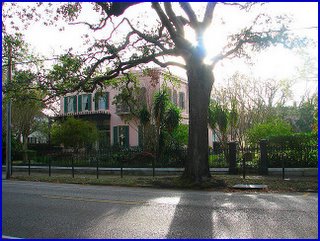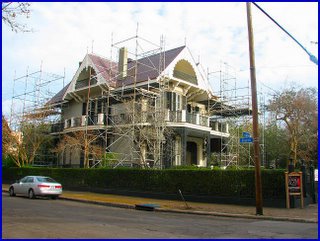



New Orleans, situated above the snake-like curve of the Mississippi River and below the enormity of Lake Ponchartrain, is a city of the water.
When the Americans began to pour into the city after the Louisiana Purchase in 1803, they discovered that the French, long ensconced east of Canal Street, were eager neither to make their acquaintance nor to welcome them into New Orleans society or government. However, there were fortunes to be made as tarriff regulations vanished in the wake of the takeover by the new little American nation and the port of New Orleans opened to trade with Europe, the eastern United States, and the western frontier. The Americans weren't going anywhere. They settled west of Canal Street and began to build their own culture, across from the "neutral zone" where peoples of all nationalities could set up necessary encounters, and a distance from what we know today as the French Quarter.
The small prestigious American enclave benefitted from Mississippi floodwaters of the early 19th century, which deposited a thick layer of silt as they seeped away. The silt destroyed sugar plantations, but created high ground for houses and fertile ground for gardens. Hence, the birth of the Garden District. I was fascinated to learn that a natural and economic disaster not so different from Katrina had created the circumstances under which a neighborhood flourished in the decades following and was largely preserved when, 200 years later, a few inches of ground meant the difference between salvation and inundation.
As is evident from the last photograph, the Garden District did not emerge from Katrina entirely unscathed. The mansion in the bottom picture, encased in scaffolding, exists entirely under the auspices of a historical slate company from Cincinnati at the moment. One of New Orleans' most famous restaurants, Commander's Palace, has a long and difficult comeback ahead -- its sign says "We Understand."
But other homes remain mostly intact, a blue tarp here or there the only obvious sign of what happened. Perhaps there is something to be learned from the results of the flood that created the Garden District.
















4 comments:
I've never been to New Orleans, but your descriptions and photos certainly make me want to go. These pics are beautiful, and I'm learning much about the city from what you write here.
I look forward to reading more.
Judi
Beautiful photos, Robin. And they're some of the first that I've seen of Uptown and the Garden District. Many have said that the city's overbuilding is partly responsible for the devestation. Many of the most seriously damaged areas are in parts of town that are significantly below sea level or in areas that were dry solely due to the canals and levees. Clearly not a man-made disaster but that the scope was increased due to man's insatiable appetite for more more more. (Not necessarily a theory to which I subscribe but it's hard to ignore some of the facts.)
I find the third photo mesmerizing...the tree and the light...speaks so much more than words.
Robin,
I appreciate that you are a "northern" voice for this city. In so many ways our government has abandoned it, the implications of which make me very angry. Thanks for doing your part to keep it in the pubic awareness.
Peace, Virginia
Post a Comment